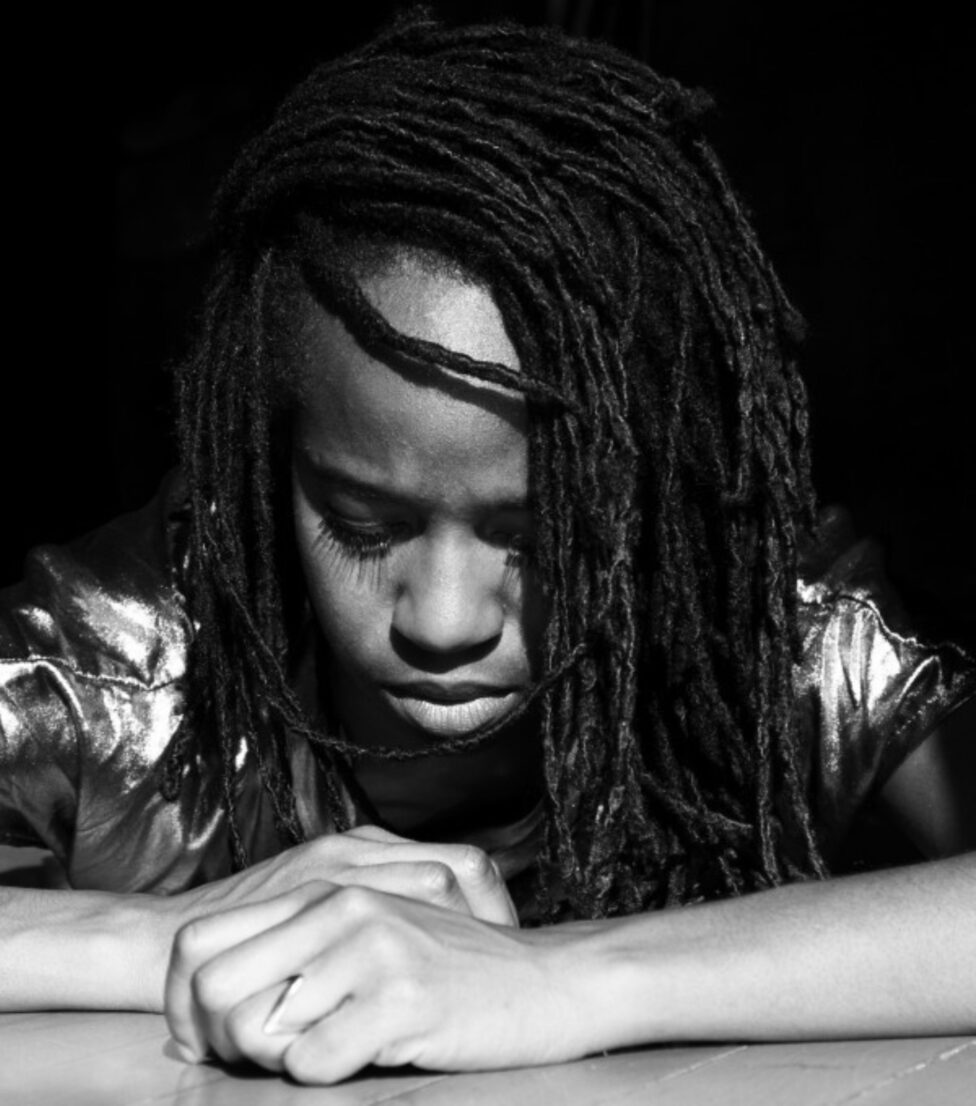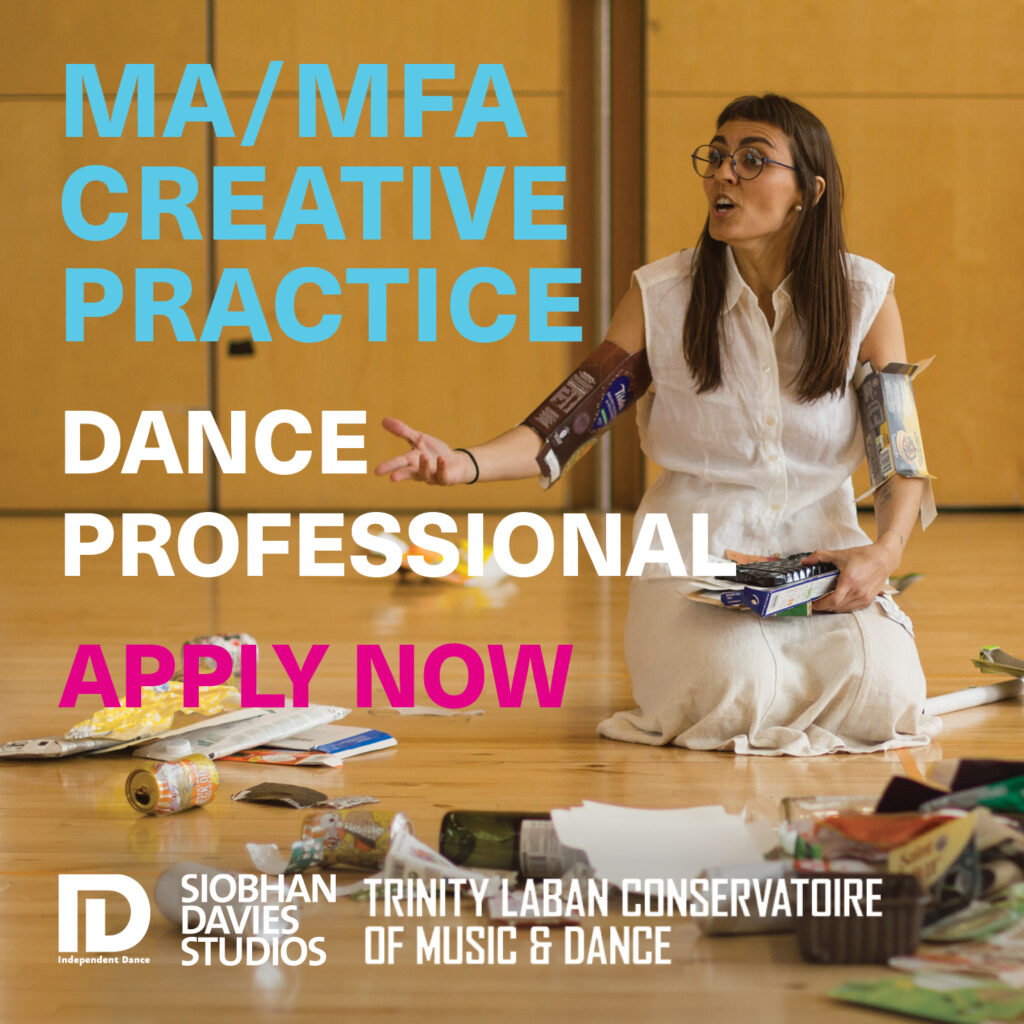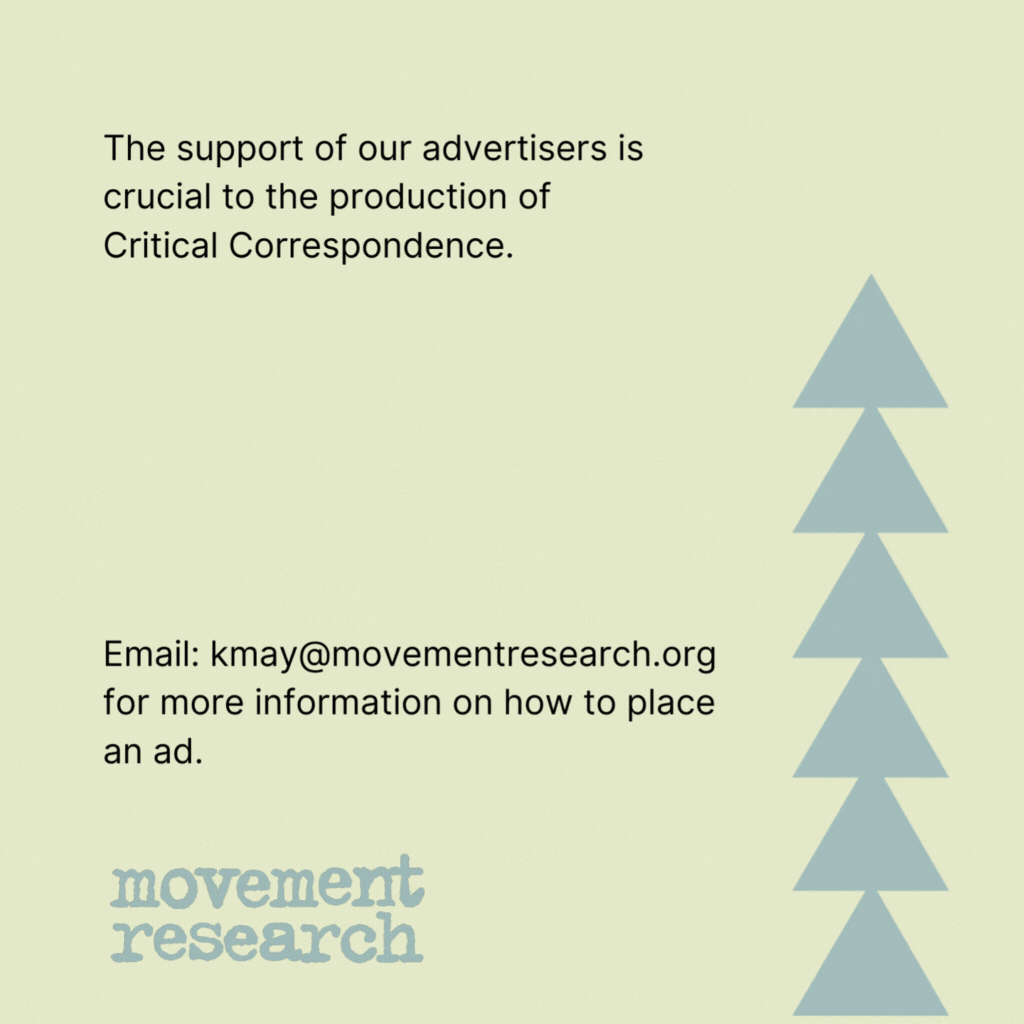Jaamil Olawale Kosoko: Thank you for sharing such an intellectually (and physically) challenging work with us during American Realness. You must feel so psychically drained.
Dana Michel: Yeah I think it’s not like about the presentation of the work, it’s just the work itself is demanding.
JOK: Of course.
DM: Just, yeah, I don’t know.
JOK: Is it every performance or just this last time would you say?
DM: But you know this is only the second run. I did the premiere at the FTA [Festival TransAmériques, Montréal, Canada]. So I just did those three and this is the first time revisiting. It’s the revisiting that’s nerve-wracking.
JOK: Because that was in May that the FTA? So you had some distance from the work a little bit. And now you’re sort of jumping back in and exploring this place. This being.
Well can we just rewind a little bit and go back to–I guess the year is 2011, and you’re at ImPulsTanz and the beginning stages of this research. Can you talk a little bit about this process and how it came into being?
DM: Well there was even like a prelude to this dance I think in the spring of that year. I had just taken a leave of absence from my day job and was trying to find a way to make a living on the side. And I thought, “I’m going to make a kid’s show. I’d like to make a kid’s show.” And I came up with this character, this half-Japanese, half-Caribbean character just because I’m kind of enamored with Japanese culture.
JOK: Sure.
DM: And I have all these mix-raced nieces and nephews and I happened to see them recently. And I don’t know, I just thought, “I’m going to delve into this.” I guess a week before I was just staring at my nephews’ mop of red hair and it just triggered this idea. All this is to say that I had this thought in the brain and I was conceiving this multi-media monster and it was just triggering these thoughts about race. And I ended up doing a tiny little experiment at FTA that year for a sort of cabaret thing and it was a trigger of delving into this research that was very new for me because I had actually specifically been avoiding dealing with race, very specifically for my short career. So that’s the prelude. And at ImPulsTanz [Vienna, Austria] I took a workshop with [Ivo] Dimchev. I had discovered his work in January of 2011. I just feel in love and was like, “Who is this man and what is his work and this needs to be? Ahh…I feel like I found a kindred something.” And then lo and behold a month later I get accepted into danceWEB [a scholarship program for dancers at ImPulsTanz]. This class [with Dimchev] was a workshop and the goal was to create a 15 min solo in a week and Ivo uses very simple exercises. We had to write a short poem, just kind of stream of thought kind of writing. So one of the first things I wrote was a tiny little poem called “yellow towel” and it was about my hair. That’s one half of the story. The other half of the story of this workshop is that we’re all sequestered into this psychiatric institution, horse stables. And there’s like 15 of us in the class. And he [Dimchev] has constructed these tiny little cabinets that we each work in out of white cotton fabric and wood and we’re all fifteen of us in these cabinets all day long, all week long. Fifteen of us. And it’s a voice workshop.
So the first thing I did, I didn’t use my voice. And after I did whatever I did, he’s like, “Uhhuh…so how come you’re not working on your voice?” For years I had been questioning the use of text and voice in work and I tended to take these very dogmatic stances like, “The body is enough. I don’t need to use text. And text is a cop-out and it’s too easy and I can do it with my body.” So I kind of said this to him and he said, “Uh huh, tomorrow I’d like you to come and I’d like you to use your voice,” and I was like, “Alright.” And I remember just being on the floor in that little space all day long. We start at like eight in the morning, and by two, I was just going bananas. The person next to me is singing Brittney Spears in an Italian accent and you just have all this crazy noise around. I’m quite over-sensitive and too respectful sometimes of other people’s space and I was too shy and like, “I can’t interfere with their work. And yet I’m supposed to be doing work.” And eventually I put myself into this position and apparently it was a position I took when I was a child to comfort myself and now it’s a position I take when I’m drunk.
JOK: Child’s pose?
[Laughter]
DM: I got into that position and I started groaning. It wasn’t a test of anything, it was just a legitimate, “Oh my god, get me out of here!” And then that just grew and I just went with it. So that was the beginning of Yellow Towel. That section on the table. It was the first impulse.
Photo of Dana Michel by Maya Fuhr
JOK: Could you talk a little bit about your relationship to legibility with this work and how you are pushing against it or interacting with that?
DM: Basically I went about things by pulling up a few very hyper-legible black culture stereotypes. It wasn’t as though I wrote a list. I was just working on the piece in bits and pieces over a couple of years and something would just naturally emerge. And I would use a very obvious object like a banana, or a trumpet, or an Afro. And then consciously and not consciously–probably more consciously than not, I just worked on blurring the fuck out of that.
JOK: I think you succeeded.
[Laughter]
I was able to read into all these things, deeply. And I found it hilarious. I think I was the only one laughing in the audience. But I absolutely loved how you were interacting with these objects and abstracting them. It seemed to me that you were fully engaged in your own psychosis and timing and understanding of the body in a deep way. It felt deeply investigated and highly theatrical. I feel this piece really showcases you as a quite brilliant performer. I’ve seen you in Keith Hennessey’s work also and so, which is a completely different way of being.
DM: …That’s a whole other…
JOK: Has working with him influenced you at all?
DM: I met Keith that same summer [before Hennessey’s workshop] I worked on the solo. Granted, I worked on the solo the first week of ImPulsTanz and for sure taking Keith’s workshop was very, very mind blowing. That summer was a very important summer for me professionally and personally. I was able to meet a whole new slew of makers and performers that I had not had any exposure to before. Had no idea who they were. So I saw a lot of work, took a lot of classes, and kept getting a lot of new ideas and Keith for sure was…
JOK: One of those new ideas!
[Laughter]
DM: After taking his workshop and seeing his piece I went up to him and… “Woah, woah, woah! What’s this work that you’re doing? This is phenomenal!” And he was feeling really kind of shitty about what they had presented at ImPulsTanz. No, I’m like, “Thank you very much for this kind of honest, not honest, you know whole look at…”
JOK: Well it seems to me that you are giving such a clear strong performative proposal to the landscape, to the–would say to the entire canon in a way, specifically as a woman of color. And dealing with ideals of behavior and what is proper, what is improper, how one should behave in the public space, and more specifically, how one should behave in front of those who are other, or of another nationality. In this particular stance, I cannot help but make the relationship between the black body and a white audience and the white gaze and it seems to me that you are in a direct…I don’t want to say “rebellion,” but you seem to not be restricted by performing a specific ideal of black beauty for a particular gaze, if you will. Does that make sense? Would you agree with that?
DM: Mmmhm. In fact, there’s like a lot of strands of motivations for this work and one of these strands…again I was talking before about how I had gone out of my way to not make “black work” and not address blackness in my work because from the get go, from the start of my career, every critique that was ever written, every conversation, every conversation with the lighting designer, it was always brought back to, “Oh you’re clearly doing African dance, you’re clearly influenced by hip-hop, you know…” And I just wanted to do that work that I needed to do without it being put in any kind of particular box. I was going out of my way to not talk black and in this piece, after all of these years of going out of my way to not do black things and repeatedly the critiques of… “black, black, black, black, black, black,” I’m like, “Ok, you want black? I’ll give you black.”
[Laughter]
JOK: But I will give you some deep space, infinite black.
Photo of Dana Michel by Maya Fuhr
DM: I’m just like, “Ok this is the black piece.” This is kind of how I was talking about it for a long while. This is my black, this is my interpretation of black work, whatever this means.
JOK: And that’s why I say again, I think it’s just a brilliant proposition and it’s just so self-understood, so embodied, deeply complicated, and mystifying. But at the same time, you’re so clear. And I’m questioning, “Is it because I am of a specific experience that I’m able to read into all these things and I really gravitate to them? Is it because I’m an artist also and I am very interested in the same ideals and ideas and your approach? Is it because I’m an academic and I’m reading these books and I’m really invested?” I don’t know! But whatever it is, it spoke to me so deeply. I think there was one point where I was literally shaking my head and crying with tears. I mean it was funny, though. And just this mash-up of various iconographic images that you completely distort and rearrange all in one body. I just found it such a wonderful exploration of presence and complexity. And maintain this presence throughout the 75 minutes. Do you ever feel self-conscious? How do you get over being misread or being misunderstood–I suppose because the piece seems to be such a metaphor for that?
DM: There’s no fear of being misread or misunderstood because my goal is not to put forth any specific message. I’m dealing with different questions and images and sensation and feeling and etc. And I put it together and I put it forth. I often quote Jim Jarmusch–I was watching the bonus of some DVD and he said, “My job is to put it out there and it’s not my job to explain it nor is it to understand it. It’s to put it out there.” And this speaks to me a lot because it’s fantastic and it’s beautiful, because people can take what they need to take or not take and it’s all important and it’s all valid. And so there’s not fear of being misunderstood. Mmmm, is that completely true? It’s probably not entirely true. Yeah it’s probably not entirely true, but I’m going to stick with that for now.
[Laughter]
I’m thinking about when I was doing interviews before the FTA and I had this interview with Actualité, a Québécoise popular culture magazine. We had this fantastic discussion and I felt really good about it and I thought, “Wow, that’s great. He gets it.” And then the article came out and it was repulsive. The way that he referred to my dreads—“les tresses Africaines” which, translated, is “African braids.” You know just belittling things like this, or he talks about my son. He finishes off the article with, “I met her son…aussi blanc que le père…” [“just as white as the father”]. What is he saying? What does this have to do with the conversation we had? In conversation or my personality sometimes, when I speak to people, I feel like I can convey one thing and they write about this and then people come into the performance with an expectation, which is nowhere close to what I‘m going to give them.
JOK: Which I also absolutely love.
[Laughter]
And I could tell that you delved so deep into the nether regions of yourself. And it’s such an exposé of individuality, not only of blackness or whatever, but it’s of a selfness that you are sharing and it’s such a generous sharing and gift.
Thank you so much for putting forth this proposal and for sharing it with us here in the NYC.
DM: Thanks for coming and watching and for talking with me. It’s nice to also have an opportunity to talk to a black man about this work.









